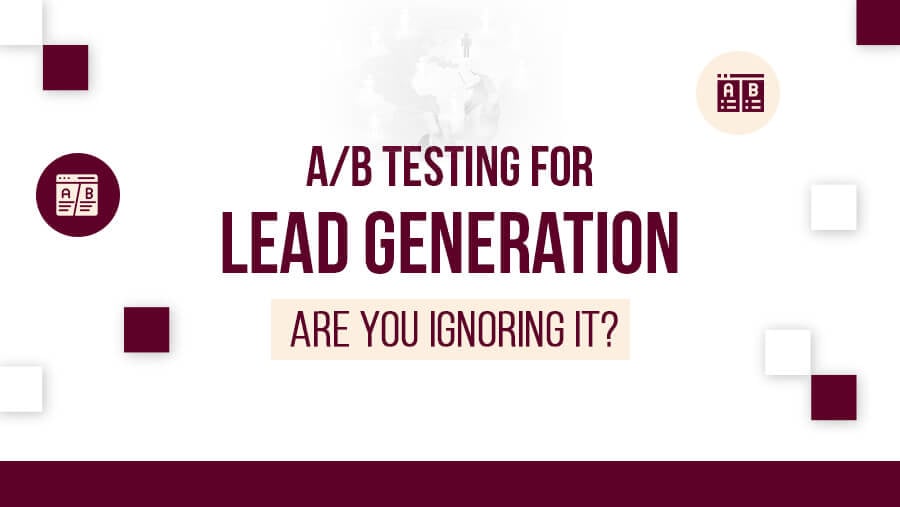
A/B Testing for Lead Generation: Are You Ignoring It?
When crafting a sales copy, sending out LinkedIn invites, or launching a website, relying solely on your instincts can be ineffective.
How do you know if your sales copy is working? How do you ensure your LinkedIn invites, website, and other marketing materials resonate with your target audience?
The answer is A/B testing.
Without data-driven insights, you may struggle to understand what resonates with your target audience. Hence, it may result in ineffective messaging, low response rates, and missed opportunities.
A/B testing is essential for lead generation. According to a study by HubSpot, A/B testing can increase conversion rates by 49%. That means more leads, sales, and revenue for your business.
A/B testing compares two versions of a message, design, or offer to see which one performs better. By measuring each version's response rates, clicks, leads, or conversions, you can identify the best practices for your target audience and optimize your marketing campaigns.
This guide will show you how to use A/B testing for lead generation and share some tips and best practices to help you get started.
What Is A/B Testing for Lead Generation?
A/B testing, also known as split testing, is a randomized experimentation process. Here, two or more versions of a campaign or website are sent to different user groups simultaneously. It’s done to see:
- Which version yields better results
and
- Which version Influences desirable actions
However, A/B testing can be tricky if you're unsure how to use it and interpret data correctly. Incorrectly analyzing A/B testing results can lead to misguided strategies and wasted resources.
To help you out, we’ve come up with this detailed blog. It will cover:
- The benefits of A/B testing
- How to conduct split testing the right way
- How to properly analyze the results
We'll also show you how to apply A/B testing to your lead generation strategy for increased conversions. Let's get started!
How Can A/B Testing Help with Lead Generation?
A/B testing is an effective tool for optimizing your lead generation process. You can experiment with different variations of your messaging, design, and targeting.

As such, you can identify the most effective combination to generate more leads and increase your revenue. Let’s understand these upsides in greater detail:
1. Effective Messaging
A/B testing can help you find the communication that resonates best with your target audience and generates the most leads. In addition, you can determine which version is the most effective by testing different messaging variations.
2. Data-Driven Decisions
By experimenting with different variations of your messaging, design, and targeting, you can gain concrete insights into what works and what doesn't. Moreover, it means you can make informed decisions about optimizing your marketing efforts rather than relying on guesswork.
3. Improved User Experience
A/B testing can identify the design elements, colors, and layout by testing different variations of your web page or landing page. As such, you can create the most engaging user experience, which results in maximum conversions.
4. Enhanced Engagement
You can create a more engaging user experience by continuously testing and improving your marketing strategy. Hence, you achieve higher levels of engagement and more qualified leads. In addition, it can result in increased revenue and overall business success.
5. Optimized CTAs
A/B testing can determine the best way to encourage leads to take action by testing different variations of your call-to-action (CTA) buttons, such as color, wording, and placement. In addition, it allows you to optimize your CTAs to generate the most leads.
6. Refined Targeting
A/B testing can experiment with different audience segments to identify the one that generates the most leads. You can refine your targeting by testing diverse audience targeting methods and optimize your marketing efforts accordingly.
7. Cost-effective Optimization
A/B testing is a highly cost-effective way to optimize your marketing campaigns or website. You need not make significant investments without knowing how your audience will respond.
Instead, you can test changes on a smaller scale. Next, you can check what works best for your firm. Since you start small, you can save time and money in the long run. Additionally, it leads to a more effective and efficient marketing strategy.
8. Increased Conversion Rates
You can increase sales lead conversion rate by identifying the most practical combination of messaging, design, and targeting through A/B testing. Continuously refining and improving your lead generation efforts can generate more leads and ultimately increase your revenue.
How Can You Execute A/B Testing?

Following the below-mentioned steps, you can conduct a successful A/B test and optimize your lead generation efforts to improve your results.
1. Set Your Objective
Start by defining what you hope to achieve from your A/B test and ensure the objective is specific, measurable, and aligned with your business goals.
For example, your objective could be to increase the number of organic leads generated by your website. Suppose you aim to boost this number by 10% over the next three months. In this case, data and research should back your target. Plus, the goal should be achievable within the given timeline.
2. Identify Test Elements
Select the variable you want to test. Base it on what is likely to have the most significant impact on your desired outcome. It could be anything from the headline, to the images, to the CTA.
When choosing the variable, make sure it is something that can be easily changed. Also, check if it has the potential to impact your conversion rates significantly.
3. Create Test Variations
After deciding what to test, create two versions of your website or campaign - Version A and Version B. Clearly define the differences between the two versions. Moreover, each version should represent a valid hypothesis.
For example, if testing the color of a button, Version A could be green while Version B could be red.
4. Make the Test Statistically Significant
Ensure your A/B test has a sufficient sample size to be statistically significant. A rule of thumb is to have at least 100 conversions per variation.
NOTE: The larger the sample size, the more confident you can be in your test results.
Furthermore, make sure to run your test for a long enough period. Plus, take into consideration the normal fluctuations in your conversion rate.
5. Split Your Audience
To ensure an accurate comparison, split your audience into two groups – one that will see Version A and another that will see Version B. It’s usually done randomly and equally to eliminate bias and guarantee a fair comparison.
6. Track and Measure Results
Once your test is live, you need to track and measure the results of each version. You can use tools like Google Analytics to track:
- Click-through rates
- Bounce rates
- Time spent on the page
But, again, ensure the data you collect is quantitatively conclusive.
7. Analyze and Interpret Outcomes
After collecting data for sufficient time, you must analyze the results to determine which version performed better. It involves comparing the metrics collected from both versions and deciding whether the difference in results is statistically significant.
8. Implement the Winning Variation
Based on your test results, you must decide which version to adopt as the new, improved version. If Version A performed better, keep it. If Version B performed better, embrace it and continue to test and optimize.
A/B Testing Best Practices
Now that you know the exact steps to implement A/B testing, here are some best practices to ensure your tests generate the highest conversions:
1. Keep the A/B Test Simple
Start with small, simple tests and make only a few changes at a time. As such, you can easily identify what is driving the results and make informed decisions.
Next, you can utilize the insights gained from these tests to run more complex tests in the future. As a best practice, limit the changes you make in each test to only one or two elements.
2. Control Outside Factors
Consider factors such as seasonality and marketing efforts that may affect your results and try to control them.
For example, if you run a test during the holiday season, consider the increased traffic and conversions likely to occur. You can control these factors by running your test over a more extended period or comparing your results to the same period in previous years.
3. Use a Reliable Tool
Use a reliable, easy-to-use A/B testing tool with a proven track record. It will help you confidently set up, run, and analyze your tests. Some popular A/B testing tools include Google Optimize, VWO, and Optimizely.
4. Test One Element at a Time
Test only one element at a time to ensure you can accurately identify the cause of any observed effects.
For example, if you are testing a new headline, ensure all other elements on the page remain the same between the two variations. It will help you isolate the headline's impact on your conversion rate.
5. Consider the User Experience
Always keep in mind the user experience. It ensures your customers have a seamless and quick browsing experience on your website. Therefore, it is vital to prioritize UX in your tests.
For example, let's assume you're testing a new CTA. You need to ensure it is easy to find. The CTA should also clearly convey what the user will receive in return.
A/B Testing Elements to Generate Leads

When improving your lead generation efforts, you can subject various elements in your marketing campaign or website to A/B testing. It can help you determine which version performs better, leading to better results. Here are some common A/B testing scenarios you might consider:
1. Landing Pages
Your landing page is the gateway to your business. In fact, it’s the first thing a potential customer sees. Therefore, it’s crucial to make an excellent first impression. In addition, a well-designed landing page can make a difference in the number of leads generated.
You can see which version generates the most leads by testing different elements of your landing page, such as –
- Headlines
- CTA buttons
- Images
- Color schemes
For instance, you can test other headlines highlighting the benefits of your product or service to see which resonates best with your target audience.
2. Email Campaigns
Testing different subject lines for an email marketing campaign can greatly affect your open and click-through rates. A subject line that grabs the reader's attention and entices them to open the email can significantly improve the success of your email campaign.
You can test subject line variations, such as:
- Different lengths
- Emojis
- Personalization
– to see which one resonates best with your audience.
Again, the sender's name can markedly affect open rates. Try sending emails from different people in your company, such as your president, sales rep, or customer service representative. Then, check which sender generates the most opens and clicks.
For example, it may be that an email coming directly from a sales rep who has an established relationship with the contact will get a larger open rate than an email from your CEO.
3. Form Fields
The number and type of form fields on your landing page can greatly impact the conversion rate. Therefore, it's essential to find a balance between:
- Asking for enough information to qualify a lead
and
- Not asking for too much information as it can deter potential customers from filling out the form
You can determine which generates the most leads by testing multiple variations of your form fields.
For example, you can test:
- A form with a single field for email addresses
Vs.
- A form with multiple fields for name, email, phone number, and other information
You can also test different form fields, such as radio buttons, checkboxes, or drop-down menus, to see which generates the most leads.
4. Pop-up Windows
Pop-up windows can get people to sign up for your email lists and blog subscriptions. However, they can also be intrusive and annoying to users.
Hence, test different pop-up windows with varying colors, CTAs, and wording. Then, you can identify the best way to nudge your users to engage without interrupting their browsing experience.
5. Offer Variations
Testing different offers, such as discounts or free trials, can help determine which is more appealing to your target audience. In addition, you can test different variations of your offer to select the version that generates the most leads or conversions.
For example, you can test a percentage-based discount versus a dollar-based discount or a 7-day free trial versus a 14-day free trial.
6. Statistics
When presenting statistics, making them easily digestible for your audience is crucial. Experiment with different ways of displaying statistics, such as:
- Using wording like "250,000 users" instead of "a quarter million users"
Or
- Creating an infographic instead of using plain text
It can impact how your audience perceives the information you're presenting. Remember: data doesn't lie. However, it can be misleading or confusing if not presented in a clear and concise way.
7. CTA Buttons
Your CTA button is the final step in the lead generation process. It plays a vital role in encouraging potential customers to take action. You can determine which one generates more leads by testing different variations of your CTA button, such as:
- Text
- Color
- Size
- Placement
For example, testing different text variations like "Get Started" vs. "Try for Free" can help you determine which wording is more effective in driving conversions.
Additionally, testing different colors and placements of the CTA button can help you find the optimal position that attracts the most clicks.
For example, a larger CTA button or a more prominent placement on your landing page may lead to more conversions.
8. Customization
Testing personalized and generic messaging can help you determine how to engage your audience. Personalization can include:
- Using the reader's name
- Addressing their pain points
- Their previous purchase history
By testing personalized messaging against generic messaging, you can see which one leads to higher engagement and conversion rates. It can help you create more targeted marketing campaigns.
9. User Experience
Testing different layouts, navigation, or other elements of the user experience can impact lead generation. By testing these elements, you can determine how to optimize your website or marketing campaign to generate more leads.
10. Social Media
A/B testing can help you identify which social media practices perform best.
For example, test different profile pictures, bios, and layouts to see which version generates the most engagement from your audience.
You can also use A/B testing to test ads on social media platforms to see what generates the most clicks and conversions.
Incorporating A/B Testing Into Lead Generation Strategies
Integrating A/B testing into your overall lead generation strategy ensures you get the best results and achieve your goals. Here are some tips to help you get the best results:
1. Prioritize A/B Tests
A/B testing should be a top priority in your lead generation strategy. Allocate sufficient resources, including time and budget, to conduct effective tests. Remember that A/B testing can notably affect your bottom line, so it's worth the investment.
2. Conduct Regular Tests
It's important to test regularly and make continuous improvements. Allocating resources to conduct regular tests and analyze results will help you stay on top of your lead generation efforts. As a result, you will achieve better outcomes over time.
3. Utilize the Right Metrics
A/B testing provides valuable data that can inform your lead generation strategy. Make sure you use the insights from A/B testing to make data-driven decisions. Only then can you achieve better results. Eventually, you can optimize your approach based on what works best.
4. Make A/B Tests a Part of Optimization Strategies
While A/B testing is crucial, it's important to complement it with other optimization methods, such as:
- User feedback
- Analytics data
- Market research
As such, you can make more informed decisions and achieve better results.
5. Practice Ongoing Optimization
A/B testing is not a one-time event. It’s an ongoing process of testing and optimizing your lead generation strategy to improve your results. Hence, you must evaluate your approach and adjust to stay ahead of the competition.
Implement A/B Testing in Your Lead Generation Strategy
As it’s clear by now, A/B testing is a MUST to include in your lead generation best practices to increase your revenue. Experimenting with different variations of your messaging, design, and targeting helps identify the most effective combination to generate more leads.
Plus, the insights gained through A/B testing can help refine and improve your marketing strategy. Therefore, it ends up leading to higher conversion rates and greater success.
Our team at Revnew implements A/B testing for all our marketing campaigns, resulting in million dollar conversions for our clients. Do you want to know more? Get a strategy call now!




